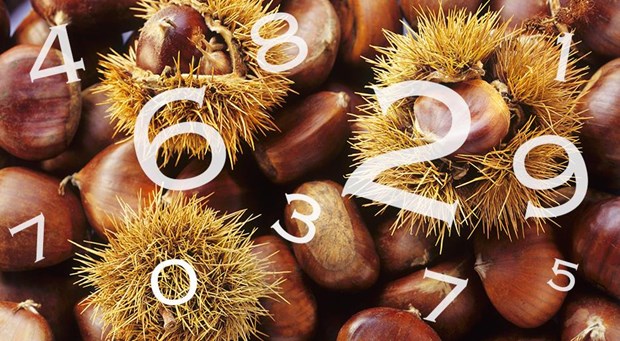Chestnuts' nutrition facts, consumption figures and recipes: a focus on one of the best loved and most widely consumed autumn delicacies.
7
is the maximum number of fruits one chestnut husk can contain. 3 if the
chestnut is a marron or sweet chestnut, a close relative obtained by
cross-breeding chestnuts. You can tell sweet chestnuts from horse chestnuts by
their size, which is generally larger, and their slightly lighter colour.
12
are the principal species of chestnuts, which can be classified as European,
Asian or American varieties. The only species from the Old Continent is the
Castanea Sativa, while those originating from Asia are the Castanea Crenata,
Castanea Mollissima, Castanea Davidii, Castanea Henryi and the Castanea
Seguinii. The typical species of the American continent are the Castanea
Dentata, Castanea Pumila, Castanea Alnifolia, Castanea Ashei, Castanea
Floridiana and the Castanea Paucispina.

57.9
metres was the girth recorded in 1780 of the Hundred Horse Chestnut tree, the
widest and oldest chestnut tree still alive in the world today. It stands in
Linguaglossa, on the slopes of Mount Etna in Sicily, at just 8 Km from the
volcano crater. It was previously believed to be 2000 years old but, according
to recent studies, it could even be as old as 4000 years. Its name derives from
a legend which narrates that a queen of Aragon, accompanied by one hundred
horsemen, found refuge under the branches of this mighty tree during a terrible
storm.
60
metres is the height some Castanea Dentata trees can grow to, this being the
largest variety of chestnut. Tree height varies considerably from one species
to another but it generally averages around 10 - 15 metres.
213
Kcal per 100 grams of chestnuts. These calories are mainly generated by the
45.54 grams of carbohydrate content, together with 2.42 grams of proteins and
2.26 grams of fats. Despite resembling a “dried” fruit the chestnut contains
quite a lot of water: in fact, in 100 grams we find about 49 grams of water. It
also contains a fair quantity of micronutrients: 519 milligrams of potassium,
for example, along with 93 milligrams of phosphorus and 27 milligrams of
calcium.
500
grams of chestnuts are required to make a delicious soup for four people. Cut a
cross on the outer skin before boiling the chestnuts in water for half an hour.
Then, leave them to cool so that you can peel them. Meanwhile, prepare a
vegetable stock using plenty of onion, a couple of carrots and two celery
stalks. When the stock is ready add the chestnuts, and put everything on to
boil again for a further 30 - 40 minutes. Finally, blend the contents of the pan
adding 50 grams of butter and a little olive oil and you will have a delicious
pureed soup.
1790
is the year in which the recipe for glazed chestnuts first appeared on the
scene. The document containing it was titled “The Piedmont confectioner who
explains how to confection fruit in various ways, and how to make biscuits,
marzipan, canestrelli biscuits, aquavit, sorbets and many other similar recipes
of the trade”. In actual fact, the recipe probably dates back to the 1500s and
its origin is a matter of dispute between Italy and France.
17,951
tons of chestnuts are imported from China, which is also the world’s greatest
consumer of this nut. In this special ranking list, it is closely followed by
Japan (17,397), Italy (5,926), France (5,457) and the United States (4,056).
China is also the world’s number one chestnuts' exporter. This country is
closely followed by Turkey (60000 tons), Italy (58000), South Korea (56000) and
Bolivia (54000). The overall world production of chestnuts is around two
million tons per annum.
The
earliest evidence of chestnuts dates back 10 million years. It would actually
appear that the origin of this plant can be traced back to the Tertiary period,
when it was already widespread in Asia, Europe and the American continent. With
regard to the use of the nut itself, the earliest evidence we have actually
comes from Ancient Greece, when it appeared in the writings of Hippocrates and
Theophrastos, who referred to it using the terms “flat nut” and “acorn of
Zeus”.
By FDL